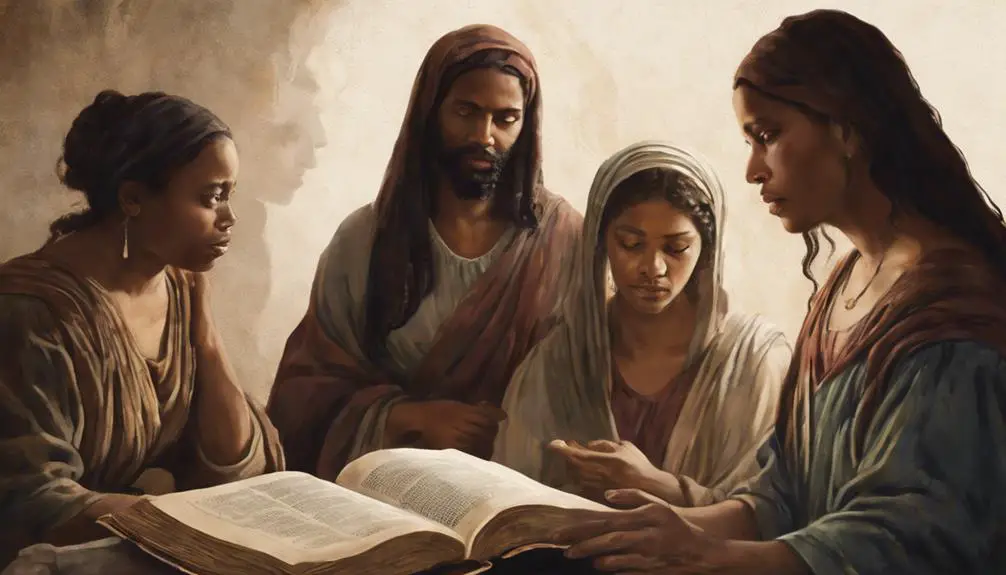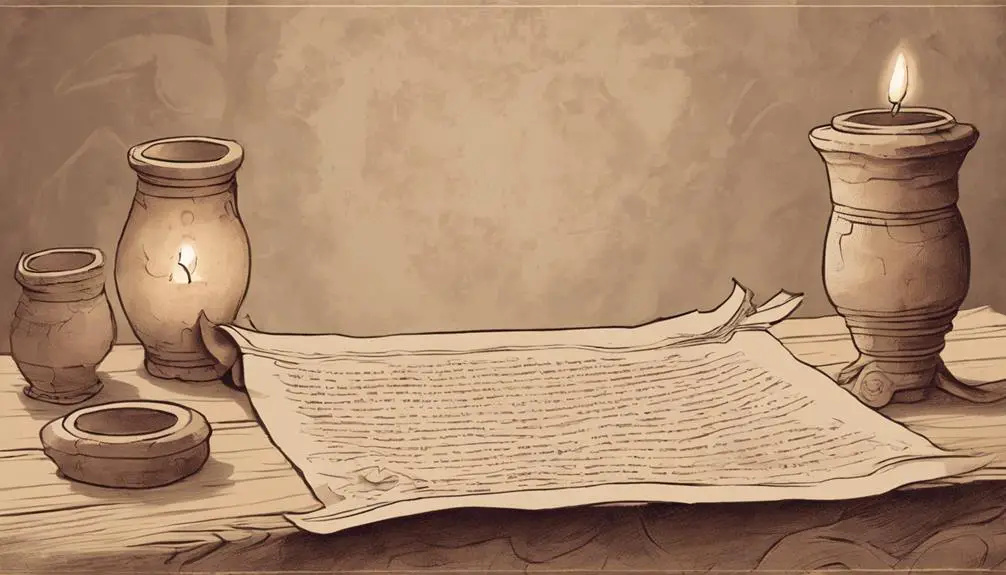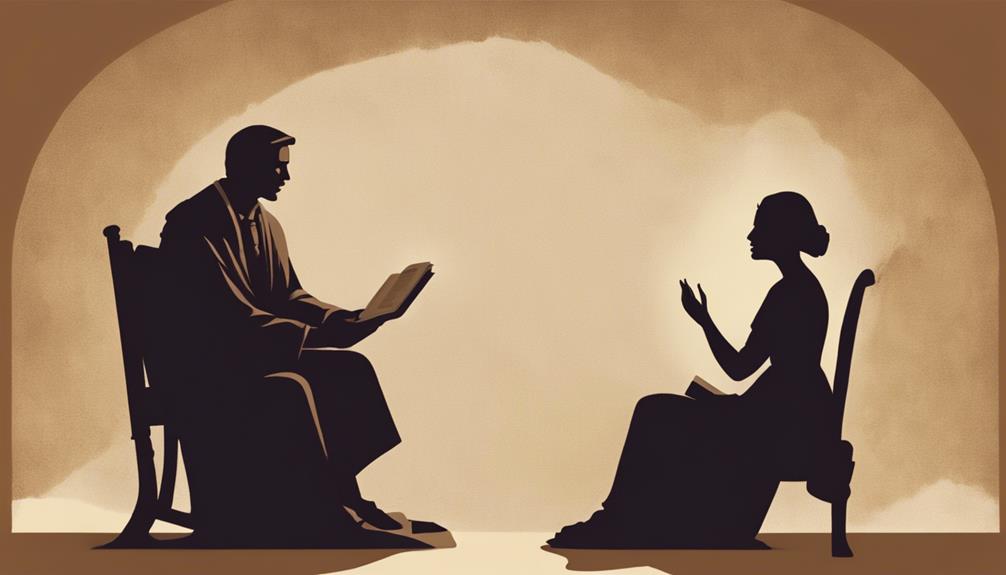Delve into the controversial realm of biblical passages perceived as sexist, and discover how ancient words shape modern debates on gender equality.

Sexist Quotes in the Bible
Have you ever pondered how ancient texts influence modern views on gender? The Bible, replete with wisdom, also contains passages that seem starkly sexist, from Paul's views on women to the creation of Eve.
These scriptures, dictating laws regarding purity and the roles of women in marriage and church, have sparked debates for centuries. As you consider the impact of these writings, you're invited to explore not just the historical context, but also how they resonate or clash with contemporary values.
This journey promises to uncover layers of interpretation and provoke thought on enduring issues of gender equality.
Key Takeaways
- The Bible contains quotes that have historically justified women's subjugation.
- Cultural context heavily influences the interpretation of biblical views on women.
- Some biblical quotes explicitly advocate for women's silence and submission.
- Modern debates challenge traditional interpretations, advocating for gender equality.
Paul's Views on Women

Paul's epistles in the New Testament reveal a complex perspective on women, often interpreted as restrictive and indicative of the era's gender norms. When you delve into Paul's writings, it's crucial to understand the cultural context in which he was operating. His messages, although seemingly straightforward, are enmeshed in the societal norms of the 1st century. This doesn't excuse or fully explain the perceived sexism, but it does provide a framework for understanding the complexity of Paul's views.
Analyzing Paul's legacy, it's apparent that his influence on Christian thought and doctrine has been profound. However, it's also essential to discern between his cultural biases and his theological insights. By doing so, you get a clearer picture of the man, his beliefs, and the times he lived in. Paul's epistles, while reflective of their time, have been interpreted and reinterpreted through the centuries, each era reading its biases into his words.
Understanding Paul's perspective requires a nuanced approach that considers both his cultural context and the lasting impact of his words on Christian theology and societal norms regarding gender. This analytical lens allows for a more comprehensive grasp of his legacy, beyond the surface-level interpretations that often dominate discussions about his views on women.
The Creation of Eve

In analyzing the biblical narrative of the Creation of Eve, one must consider the cultural and theological implications embedded within the text. This narrative has not only shaped the perception of gender roles within many societies but also invites a comparison with other creation myths in comparative mythology. Through an analytical lens, it's essential to dissect how Eve's creation from Adam's rib has been interpreted and its impact on societal norms regarding gender.
Aspect |
Biblical Narrative |
Comparative Mythology |
|---|---|---|
Source of Life |
Adam's rib |
Varied origins |
Role in Society |
Companion/helper |
Creator/Destroyer |
Symbolism |
Subservience |
Empowerment |
Interpretation |
Literal/Allegorical |
Cultural reflection |
This table illustrates the stark contrasts between the biblical account of Eve's creation and its counterparts in comparative mythology. While the Bible positions Eve as a secondary creation, meant to be Adam's companion, other myths often portray female deities or figures in roles of greater power or equal standing. The symbolism inherent in Eve's creation story has perpetuated a view of women as subservient, a narrative that continues to influence gender roles today. This analysis underscores the importance of examining these texts within their cultural and historical contexts to understand their impact on contemporary views of gender.
Laws Regarding Purity

Delving into the biblical laws regarding purity reveals a complex framework that significantly shaped societal norms and personal conduct. These regulations, deeply embedded in the religious texts, had profound implications on the daily lives of individuals, especially women.
The laws surrounding purity can be particularly understood through:
- Menstrual Taboos: Women were considered ritually unclean during their menstrual cycle, leading to restrictions in their participation in religious and, in some cases, social activities. This not only had implications for the women themselves but also influenced the perception of femininity and purity in society.
- Sacrificial Rituals: These rituals were integral to maintaining communal and individual purity. They often required the involvement of both genders, but the roles and responsibilities were distinctly outlined, sometimes highlighting gender biases.
- Purity After Childbirth: The period of purification following childbirth was longer for the birth of a female child than for a male, a distinction that has been subject to various interpretations regarding its implications on gender perceptions.
- Ceremonial Cleanness: Both men and women were subject to laws regarding ceremonial cleanness, which governed their participation in religious rites. However, the criteria and consequences of impurity often varied, reflecting societal attitudes towards gender.
These laws, while reflective of their time, offer insight into the historical context of gender roles and the complexities of interpreting religious texts through a modern lens.
Wives' Submission to Husbands

Throughout history, interpretations of biblical passages have often emphasized wives' submission to their husbands, shaping societal expectations and norms around gender roles and marriage. This emphasis has frequently been used to justify a hierarchical structure within the household, where the man's authority is paramount. However, a more nuanced understanding requires you to consider the cultural context of these texts. The societies from which these scriptures emerged were patriarchal, and the directives reflected the norms and values of those times.
It's crucial to analyze whether these passages are prescriptive or descriptive of the era in which they were written. This distinction matters significantly in discussions about gender equality today. Many argue that a literal interpretation of these texts overlooks the evolution of societal norms towards more equitable relationships between men and women.
Moreover, some theologians suggest that these passages, when interpreted within the broader biblical themes of love, respect, and mutual submission, don't endorse a rigid, hierarchical model of marriage but rather one of partnership and mutual respect. They advocate for reading these texts through a lens that considers both the historical context and the overarching biblical narrative advocating for love and respect in all relationships.
Female Silence in Churches

How do biblical directives regarding female silence in churches reflect or diverge from the broader societal norms of their time? To understand this, you must delve into the gender dynamics and cultural context of the era. These directives weren't isolated statements but were part of a larger societal fabric that both influenced and was influenced by religious texts.
- Historical Context: In ancient societies, public speaking roles were predominantly reserved for men. The directives about female silence in churches echoed this broader cultural norm, reinforcing the gender dynamics of the time.
- Cultural Context: The cultural context of these societies placed a high value on order and hierarchy within the community. Silence from women in churches can be seen as an extension of these values, emphasizing the societal structure.
- Gender Dynamics: The directives reflect the gender dynamics prevalent in society, where men were typically seen as leaders both in the public and religious spheres.
- Contemporary Reflection: Today, these passages prompt critical reflection on how far societal norms and gender dynamics have evolved, challenging us to consider the relevance of ancient directives in modern contexts.
Analyzing these aspects, it's clear that biblical directives on female silence in churches were deeply intertwined with the cultural and societal norms of their time, offering insights into the historical gender dynamics.
Frequently Asked Questions
How Have Interpretations of These Biblical Quotes Evolved in Modern Feminist Theological Scholarship?
In modern feminist theological scholarship, interpretations of these quotes have significantly evolved. Scholars apply hermeneutical methods, viewing texts through the lens of cultural relativism to understand historical contexts and biases.
This approach has led to reevaluations and more inclusive understandings of spiritual texts. It's a shift from traditional interpretations, aiming to reconcile faith with contemporary values of equality and justice, critically analyzing and challenging historical perspectives.
In What Ways Have Religious Communities Outside of Christianity Responded to or Paralleled Sexist Quotes Found in the Bible?
As you delve into interfaith dialogues, you'll find that many religious communities have grappled with texts resembling sexist quotes. Through cultural comparisons, it's evident that various traditions have embarked on introspective journeys, much like peeling layers off an onion, to confront and reinterpret these passages.
This scholarly analysis reveals a shared struggle across faiths to reconcile ancient teachings with modern values, often leading to rich, nuanced discussions on gender and equality.
Are There Any Historical Contexts or Translations That Significantly Change the Perceived Sexism of These Quotes?
Absolutely, linguistic evolution and cultural relativism significantly impact the interpretation of historical texts. When you examine ancient writings through these lenses, you'll find that context and translation can dramatically alter perceived meanings.
It's crucial to understand that words and societal norms have evolved. By considering these factors analytically and objectively, you'll see that what might seem sexist today wasn't necessarily intended with the same connotation in its original historical and cultural setting.
How Do Contemporary Religious Leaders From Various Denominations Address or Reinterpret These Quotes to Align With Modern Values of Gender Equality?
You'll find that contemporary religious leaders tackle these challenging texts through cultural interpretations and reevaluations of leadership roles, aligning them with modern values of gender equality.
They often emphasize the historical context of these passages, suggesting alternative readings or focusing on the overarching messages of love and equality within their faith traditions.
This approach allows them to address concerns while maintaining the relevance of their teachings in today's society.
Can Examples of Empowering or Positive Depictions of Women in the Bible Provide a Counterbalance to the Sexist Quotes, and How Are They Typically Incorporated Into Discussions on Gender in Religious Studies?
Can't examples of empowering women in the Bible, like prophetic women, offer a fresh perspective? They're often cited in religious studies to illustrate gender symbolism and challenge outdated norms.
By showcasing these stories, scholars and leaders weave a narrative of balance and equality. They're not just countering negative portrayals but highlighting the inherent strength and dignity of women.
How do these discussions shape our understanding of gender in religion today?
Conclusion
Navigating through the biblical landscape, you've encountered terrains marked by Paul's rigid views, Eve's narrative, purity laws, marital hierarchies, and silenced female voices in congregations.
Like explorers deciphering ancient maps, it's crucial to analyze these texts with a lens that recognizes historical context and evolving interpretations. This journey reveals not just a bygone era's ethos but also prompts a broader dialogue on gender dynamics.
Engaging with these passages analytically, you're invited to contribute to an ongoing conversation on equality and understanding.



Sign up